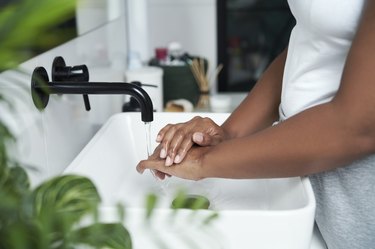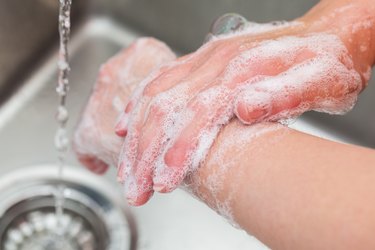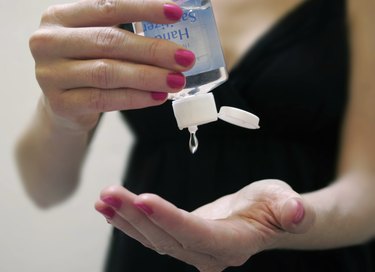
Raise your hand if you get lazy with post-bathroom hygiene (pun intended). Hand-washing is a non-negotiable 20-second part of your bathroom break — yes, a full 20 seconds — that helps protect you from germs and bacteria.
Proper hand-washing is an art, and you may be making some common mistakes that are putting you at higher risk of getting sick. From sudsing to drying, there is a science-backed, best way to cleanse.
Video of the Day
Video of the Day
Learn how to wash your hands properly — the next time you're face-to-face with the bathroom sink, avoid these five common mistakes.
1. You Skip the Soap
For most people, this seems like a no-brainer. But skipping the soap is a common mistake, says Philip Tierno, PhD, clinical professor of microbiology and pathology at NYU Langone Health.
If you're passing up the suds, you may want to re-think your choice. Washing your hands with soap and water is the best way to get rid of germs, according to the Centers for Disease Control and Prevention (CDC).
Washing with water alone will reduce bacteria to 23 percent, according to a January 2011 study in the International Journal of Environmental Research and Public Health. But using soap will reduce the total bacteria to about 8 percent, researchers found. So, skipping this extra step does make a difference.
"I see people in the bathroom just put their hands under a stream of water, no soap, and they consider themselves washed," Tierno says. "It's not about getting water on you — it's about removing particles."
When to Wash Your Hands
- After using the bathroom
- Before and after preparing food
- Before you eat
- Before and after you come in contact with someone who is sick
- Before and after diaper changes
- Before and after treating a cut or wound
- After coughing, sneezing or blowing your nose
- After touching an animal, animal feed or animal waste
- After touching garbage
- After touching shared surfaces, such as in the gym or on a train
"The whole idea is to cut down on the number of [germs] you introduce from your hands to your mouth, eyes or nose, which are the conduits of entry into your body," Tierno says. "That's how you get sick 80 percent of the time."
2. You Don't Scrub Long Enough
Most people also fail to spend enough time at the sink, Tierno says. Technically, you should lather your hands for at least 20 seconds, according to the CDC. For reference, that's about the time it takes to sing the "Happy Birthday" song twice through.
The length of time you wash your hands affects how much bacteria you're able to eliminate. A 20-second wash results in greater reduction of germs than a shorter, 5-second wash, according to a July 2012 study by the International Association for Food Protection.

3. You Don't Lather Your Entire Hand — Nails Included
When you wash your hands, surface area matters. And although you mostly use your fingers to grab objects or type on your computer, it's important to also get the soap on the backs of your hands and between your fingers, according to the CDC.
Don't forget to thoroughly clean under your fingernails, too, where a lot of germs can be lurking, Tierno says. The best way to do so is by scraping your soapy palm.
And don't stop at the bottom of your palm. You'll want to wash about an inch up toward your wrist to make sure you're eliminating as much bacteria as possible.
Read more: A 7-Day Kickstart Plan to Boost Your Immune System
4. You Re-Contaminate Right After Washing
Most public bathrooms have automatic sinks these days. But if the sink you're using shuts manually, don't turn it off immediately after washing, Tierno says. By touching the sink with your freshly washed hand, you expose your skin to the same germs present before you washed them.
The same goes for the paper towel dispenser. If the dispenser isn't automatic, you'll want to dispense the paper towel prior to washing. Then, after you dry, turn off the water and open the bathroom door handle using the paper towel, not your squeaky clean hand.

5. You Rely Too Much on Hand Sanitizer
Hand sanitizer is convenient, and an alcohol-based sanitizer is a decent on-the-go alternative to hand-washing. But it isn't a replacement for washing your hands, according to the CDC. Hand sanitizers don't get rid of all types of germs and may not be as effective if your hands are visibly dirty or greasy.
There's a proper sanitizing protocol, too. Apply at least a quarter-sized dollop of sanitizer and rub it on your hands for at least 20 seconds, Tierno recommends. As with hand-washing, make sure to get the product between your fingers, under your nails and up your wrist.
Don't rub any of the excess sanitizer off onto your clothes if it doesn't dissolve right away. Either keep going up your arm or just keep rubbing your hands until they're dry.
Tip
Look for a hand sanitizer that's at least 60 percent alcohol (this will be listed as the active ingredient on the back of the bottle, typically in the form of "ethyl alcohol"). Brands that typically include this amount are Germ-X and Purell.
Proper Hand-Washing Steps
- Wet your hands with clean water (warm or cold) and squeeze some soap onto your palm.
- Lather and rub your hands together, getting the backs of your hands, between your fingers and under your fingernails.
- Scrub for at least 20 seconds.
- Rinse your hands well under the water.
- Using a clean towel or paper, dry your hands completely (germs can be transferred more easily to and from wet hands).
Tip
Before you open the tap, dispense a paper towel so it's ready and waiting for you. Then, use that same paper towel to close the tap when your hands are dry.
- Centers for Disease Control and Prevention: "When and How to Wash Your Hands"
- International Journal of Environmental Research and Public Health: "The Effect of Handwashing with Water or Soap on Bacterial Contamination of Hands."
- International Association for Food Protection: "Efficacy of Handwashing Duration and Drying Methods"
Is this an emergency? If you are experiencing serious medical symptoms, please see the National Library of Medicine’s list of signs you need emergency medical attention or call 911.